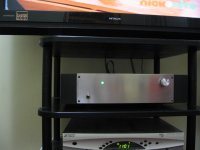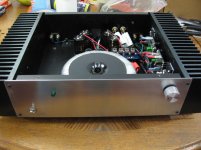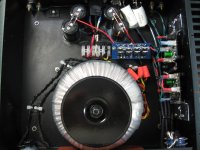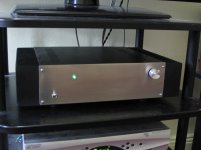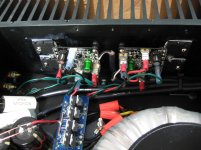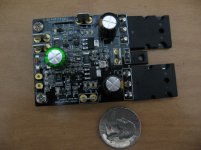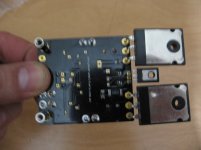Can you recommend a used commercial amp in the 900-to-1000 dollar range(used) or assembled kit companies or folks who build here at the forum or other?
Some requirements/considerations:
Solid State integrated
app. or at least 150 watts into 4 ohms
Low T.I.M figures, transient responce or maybe expressed especially step function or square wave reproduction and wide bandwidth
low distortion especially up to and above 20k
Good build, long component life at normal useage.
There are many, many talented and knowledgable people here, so I wonder what commercial companies provide un-hyped solid designs at fair prices.
Some requirements/considerations:
Solid State integrated
app. or at least 150 watts into 4 ohms
Low T.I.M figures, transient responce or maybe expressed especially step function or square wave reproduction and wide bandwidth
low distortion especially up to and above 20k
Good build, long component life at normal useage.
There are many, many talented and knowledgable people here, so I wonder what commercial companies provide un-hyped solid designs at fair prices.
Hi philmagnotta! Well, I have had some integrated amps. But the good ones around 100 watts that I can remember were. Acurus dia 100 mkii, Portal panache. With that kind of money you can buy a good used integrated amp for sure.Try Audiogon. and if you want to build your owm amp, you can get many kits from many vendors here at diyaudio. in my case I was always looking for amps buying amps have them for a couple months and sell them.Do not get me wrong here they were good ones like: Marantz, Adcom, Acurus, Bryston, Luxman, Portal panache, Blue circle etc, But I was never happy. until I found Diyaudio and got my feet wet into diy amps. With the help of many pro here you can do it too. and the best thing is some of these diy amps can easily beat some commercial amps. and you can always choose the quality of the parts that you are using in your diy amp. Here is my diy integrated amp.
Attachments
Hi lanchile:
Ok, I'll take it!
Seriously though, I understand your recommendation.
However, I do need an amp as soon as possible, since I'm in production and have borrowed an amp temporarily that is junk.
I mean I need to purchase within two weeks for mixdown and mastering.
About Audiogon, I have been looking continuously there, but the number of fancy or esoteric units have caused me to come here to see what truths I may learn about certain manufaturers' circuit claims. This is, of course nearly impossible since many of them use marketing phrases to discribe what might be easily examined if they were laid bare by experienced people on this forum.
I have learned some usefull things already, such as the article linked from DIYaudio from Floyd Tool about high damping factor being tauted as very important or a sign of audio quality... not so, says Floyd!
Even more interesting is that when I see an amp that looks interesting, I usually hit the web for as much info as possible.
Most of the info regarding commercial amps exists in the form of reviews, which I find suspisious. Since I work in the recording, mastering field, I do often have access to original source material which in and of itself is debateable since most sources are heard by the monitoring chain which may have poor or less than well designed (sonically) equipment.
Fortunately, sometimes I can evaluate by comparison to acoustic events.
typical published spec/measurements are usually devoid of more complete measuring points, as you are well aware: what types of harmonic distortions at what ratios, frequencies, power and many others as well.
So not being familiar with the social acceptabilities of this forum, since it is DIY, I wasn't sure if I could simply post a "comments" for specific units?
The ones you mentioned above were ones that I have looked at as well, but it is hard to say without auditioning, what types of performance these units might have regarding full sustained orchestra, responce to delicate harpsichord. and so on.
Secondly regarding used, the better designs being affordable only after being old, required my post to ask about commercial products whose components/implimentation versus lifespan and more important, not just lifespan, but maintains the original spec/sound over a number of years.
Of course I do realize that the above is relative to its use and invironment, etc.
So, may I post questions here regarding various units?
Ok, I'll take it!
Seriously though, I understand your recommendation.
However, I do need an amp as soon as possible, since I'm in production and have borrowed an amp temporarily that is junk.
I mean I need to purchase within two weeks for mixdown and mastering.
About Audiogon, I have been looking continuously there, but the number of fancy or esoteric units have caused me to come here to see what truths I may learn about certain manufaturers' circuit claims. This is, of course nearly impossible since many of them use marketing phrases to discribe what might be easily examined if they were laid bare by experienced people on this forum.
I have learned some usefull things already, such as the article linked from DIYaudio from Floyd Tool about high damping factor being tauted as very important or a sign of audio quality... not so, says Floyd!
Even more interesting is that when I see an amp that looks interesting, I usually hit the web for as much info as possible.
Most of the info regarding commercial amps exists in the form of reviews, which I find suspisious. Since I work in the recording, mastering field, I do often have access to original source material which in and of itself is debateable since most sources are heard by the monitoring chain which may have poor or less than well designed (sonically) equipment.
Fortunately, sometimes I can evaluate by comparison to acoustic events.
typical published spec/measurements are usually devoid of more complete measuring points, as you are well aware: what types of harmonic distortions at what ratios, frequencies, power and many others as well.
So not being familiar with the social acceptabilities of this forum, since it is DIY, I wasn't sure if I could simply post a "comments" for specific units?
The ones you mentioned above were ones that I have looked at as well, but it is hard to say without auditioning, what types of performance these units might have regarding full sustained orchestra, responce to delicate harpsichord. and so on.
Secondly regarding used, the better designs being affordable only after being old, required my post to ask about commercial products whose components/implimentation versus lifespan and more important, not just lifespan, but maintains the original spec/sound over a number of years.
Of course I do realize that the above is relative to its use and invironment, etc.
So, may I post questions here regarding various units?
Sure! go ahead and shoot all your questions! To me it is very important that an amplifier is not fatiguing at all,I want to listen to my amp for hours and hours. I have try many good commercial amps but some of them were so fatiguing that I could not listen to it more than one hour.I would never use tone controls or equalizers at all, I do not want to "change" the the "original" sound as it was recorded (if they made a mistake and they went too low or too high, I want to hear it lol). I am very picky when is sound quality. I have seen excellent commercial amps that use cheap parts and sound like a Sony receiver the ones you buy at Best buy lol.I do not say my integrated amp is the best, but I have compared it side by side with some big boys and I would laugh how my diy amp kicked their butts big time. Now I am waiting for my friend to upgrade (re-caping) his McIntosh amp since the first time we did the test and my amp beat it as the sound of the McIntosh was a little fatiguing and we blamed the "old" caps in the McIntosh.I will post results after He recaps his amp.
Hi lanchile:
Thanks for your reply.
You stated that... you've tried many good comm. amps, but some were so fatiguing, and that you've seen excellent commercial amps that use cheap parts and sound like a Sony receiver.
Please clarify "good and or excellent".
Did you mean that they are considered so by the claim of others, price or specs?
I do have some idea as to what you may mean.
For example, I have auditioned units from Krell, Mark Levinson, Conrad Johnson, early Manley units (before Eva took over), McIntosh, Futterman OTL, as well, standard off-the-shelf 200 to 400 dollar recievers, older stuff like Phase Linear 700B, Sansui, etc.
There usually exsists a few problems with auditions in general.
First, the source. If it is an acoustic one, was the instrument, person or ambient set up or presented properly?
Then there is the electronic record chain, from mic to monitors, in the tracking set up.
Here is where many problems occur, so if we speak about commercial CDs, for example, we're likely to not be impressed right at the control room monitors - at least 50% or 60% of the time!
We would have to have reference recordings to evaluate playback systems, and the luxury to evaluate the differences between the session/mastering monitors and our evaluation systems (differences in location notwithstanding).
This is not often the case. However, those who are responsible for the design of excellent units would/should have access to industry professionals from the complete recording chain, the manufacturers of that equipment...EQs, compressorss, mixing desks, patch bays, amps and monitors.
It is sometimes true that State of the Art equipment designers and manufactures do consult, evaluate and envolve themselves with all of the above.
I would like to see a situation where standards in measurement (much more than is common), especially new research towards "what measurements?", would provide for amps that meet these standards and also meet with listening expectations.
Reviewers have their favorites discs and so it is that Steroephile lists recommened components: amps X,Y,Z are excellent.
Commercially speaking, major magazines and business in general could not allow such a thing to happen for obvious reasons.
Even if such a reference amp could be established strictly from a purely scientific group, debates to challange it would follow.
Practically speaking, especially considering my specific needs, I actually do believe I can obtain a reasonably good sounding integrated.
How do I see diyaudio as an important reference?
Many people here are qualified to examine designs as to it's components and implimentation relative to:
Robustness/longevity and drift from original measurements/specs.
Matter of factly or estimated sonic performance.
What measurements are consistantly usefull in correlating audio fidelity.
Thanks for the invite to request the talents of everyone here, I fully believe this forum will be a most valuable resource.
QUOTE=lanchile;2137493]Sure! go ahead and shoot all your questions! To me it is very important that an amplifier is not fatiguing at all,I want to listen to my amp for hours and hours. I have try many good commercial amps but some of them were so fatiguing that I could not listen to it more than one hour.I would never use tone controls or equalizers at all, I do not want to "change" the the "original" sound as it was recorded (if they made a mistake and they went too low or too high, I want to hear it lol). I am very picky when is sound quality. I have seen excellent commercial amps that use cheap parts and sound like a Sony receiver the ones you buy at Best buy lol.I do not say my integrated amp is the best, but I have compared it side by side with some big boys and I would laugh how my diy amp kicked their butts big time. Now I am waiting for my friend to upgrade (re-caping) his McIntosh amp since the first time we did the test and my amp beat it as the sound of the McIntosh was a little fatiguing and we blamed the "old" caps in the McIntosh.I will post results after He recaps his amp.[/QUOTE]
Thanks for your reply.
You stated that... you've tried many good comm. amps, but some were so fatiguing, and that you've seen excellent commercial amps that use cheap parts and sound like a Sony receiver.
Please clarify "good and or excellent".
Did you mean that they are considered so by the claim of others, price or specs?
I do have some idea as to what you may mean.
For example, I have auditioned units from Krell, Mark Levinson, Conrad Johnson, early Manley units (before Eva took over), McIntosh, Futterman OTL, as well, standard off-the-shelf 200 to 400 dollar recievers, older stuff like Phase Linear 700B, Sansui, etc.
There usually exsists a few problems with auditions in general.
First, the source. If it is an acoustic one, was the instrument, person or ambient set up or presented properly?
Then there is the electronic record chain, from mic to monitors, in the tracking set up.
Here is where many problems occur, so if we speak about commercial CDs, for example, we're likely to not be impressed right at the control room monitors - at least 50% or 60% of the time!
We would have to have reference recordings to evaluate playback systems, and the luxury to evaluate the differences between the session/mastering monitors and our evaluation systems (differences in location notwithstanding).
This is not often the case. However, those who are responsible for the design of excellent units would/should have access to industry professionals from the complete recording chain, the manufacturers of that equipment...EQs, compressorss, mixing desks, patch bays, amps and monitors.
It is sometimes true that State of the Art equipment designers and manufactures do consult, evaluate and envolve themselves with all of the above.
I would like to see a situation where standards in measurement (much more than is common), especially new research towards "what measurements?", would provide for amps that meet these standards and also meet with listening expectations.
Reviewers have their favorites discs and so it is that Steroephile lists recommened components: amps X,Y,Z are excellent.
Commercially speaking, major magazines and business in general could not allow such a thing to happen for obvious reasons.
Even if such a reference amp could be established strictly from a purely scientific group, debates to challange it would follow.
Practically speaking, especially considering my specific needs, I actually do believe I can obtain a reasonably good sounding integrated.
How do I see diyaudio as an important reference?
Many people here are qualified to examine designs as to it's components and implimentation relative to:
Robustness/longevity and drift from original measurements/specs.
Matter of factly or estimated sonic performance.
What measurements are consistantly usefull in correlating audio fidelity.
Thanks for the invite to request the talents of everyone here, I fully believe this forum will be a most valuable resource.
QUOTE=lanchile;2137493]Sure! go ahead and shoot all your questions! To me it is very important that an amplifier is not fatiguing at all,I want to listen to my amp for hours and hours. I have try many good commercial amps but some of them were so fatiguing that I could not listen to it more than one hour.I would never use tone controls or equalizers at all, I do not want to "change" the the "original" sound as it was recorded (if they made a mistake and they went too low or too high, I want to hear it lol). I am very picky when is sound quality. I have seen excellent commercial amps that use cheap parts and sound like a Sony receiver the ones you buy at Best buy lol.I do not say my integrated amp is the best, but I have compared it side by side with some big boys and I would laugh how my diy amp kicked their butts big time. Now I am waiting for my friend to upgrade (re-caping) his McIntosh amp since the first time we did the test and my amp beat it as the sound of the McIntosh was a little fatiguing and we blamed the "old" caps in the McIntosh.I will post results after He recaps his amp.[/QUOTE]
Well philmagnotta, it is not just specification in your amp that you are looking for... it is more than that. I believe the best tool that we have to compare sound quality is our ears. it can be THD 0.000000001% costing $$$$$$$ but if it does not sound good to your ears it is just a waist of money!!!. for instance I have heard good tube amps that had high THD and the whole specification was not so pleasant to "SEE", but sounded beautifully to my ears.
The Portal panache integrated amp that I had was good but it had some downsides like the high frequencies were way too sharp and that coses to get fatigue in your ears (painful) the bass was excellent(80,000uf) with mid-range very well controlled. The design was a "minimalist" which I loved it, the parts quality were good (it could be better) The amp does not use any kind of relay
(I like it) so when you turn off your amp you will "still" listen to some music for a couple of seconds (same as Adcom amplifiers and many more).Some people do not like this ( I do not mine it now).This amp is very well build and the sound is very good, I also noticed that you can hear back noise so it is not so quiet this amp.I do not like to see or to use too many caps in an amp and if I have to use many capacitors inside of an amp I like to use the best quality as possible. for example I use in my diy integrated amp 4x10,000uf Mundorf Audio grade caps in the power supply and in my LM3875 I used Black gate caps. some people say it is a waist of money, but if I feel better using the best parts I can get....Why not?.I have had some Bryston amps, they are excellent amps for the money.
if you are in the diy fever like me lol, you should give a try to build some amps. one excellent source is Aussie Amplifiers. I got these NXV200 boards from them and they are so good that I even bought extras lol. take a look.
Specifications
110 Watts RMS continuous sine wave into 8 Ω
180 Watts RMS continuous sine wave into 4 Ω
The HPA-nxV200 is 2 Ω Stable
Biased into Class A/B
Power Bandwidth 3.5hz to 600khz -3dB
Small Signal Bandwith 3.5hz to 3.5mhz
Slew Rate = 80v / microsec approximately
Dampening Factor At 100hz 8Ω = 800
Dampening Factor At 1khz 8Ω = 650
Dampening Factor At 10khz 8Ω = 250
RCA Single ended Input impedance 33kΩ
Single Ended Input Gain = 30.6dB
THD+N - Typically 0.005%
Recommended Linear Voltage Supply +-50 volts DC
Operational Supply Voltage Range +-10v DC to +-60 volts DC
PSU Power Transformer secondary windings 35vac (225VA to 400VA)
Printed Circuit Board Dimensions 50mm x 50mm
Ultra small form factor PCB
Designed as high performance Home Theatre multi channel amplifier
Or High End 2 Channel stereo amplifier
Unconditionally Stable into any load from 4 to 16 Ohms
Extra Heavy Duty three ounce copper printed circuit board
Ground plane Layer for very low noise.
Rugged high performance complementary Toshiba MOSFET Output Stage.
The Portal panache integrated amp that I had was good but it had some downsides like the high frequencies were way too sharp and that coses to get fatigue in your ears (painful) the bass was excellent(80,000uf) with mid-range very well controlled. The design was a "minimalist" which I loved it, the parts quality were good (it could be better) The amp does not use any kind of relay
(I like it) so when you turn off your amp you will "still" listen to some music for a couple of seconds (same as Adcom amplifiers and many more).Some people do not like this ( I do not mine it now).This amp is very well build and the sound is very good, I also noticed that you can hear back noise so it is not so quiet this amp.I do not like to see or to use too many caps in an amp and if I have to use many capacitors inside of an amp I like to use the best quality as possible. for example I use in my diy integrated amp 4x10,000uf Mundorf Audio grade caps in the power supply and in my LM3875 I used Black gate caps. some people say it is a waist of money, but if I feel better using the best parts I can get....Why not?.I have had some Bryston amps, they are excellent amps for the money.
if you are in the diy fever like me lol, you should give a try to build some amps. one excellent source is Aussie Amplifiers. I got these NXV200 boards from them and they are so good that I even bought extras lol. take a look.
Specifications
110 Watts RMS continuous sine wave into 8 Ω
180 Watts RMS continuous sine wave into 4 Ω
The HPA-nxV200 is 2 Ω Stable
Biased into Class A/B
Power Bandwidth 3.5hz to 600khz -3dB
Small Signal Bandwith 3.5hz to 3.5mhz
Slew Rate = 80v / microsec approximately
Dampening Factor At 100hz 8Ω = 800
Dampening Factor At 1khz 8Ω = 650
Dampening Factor At 10khz 8Ω = 250
RCA Single ended Input impedance 33kΩ
Single Ended Input Gain = 30.6dB
THD+N - Typically 0.005%
Recommended Linear Voltage Supply +-50 volts DC
Operational Supply Voltage Range +-10v DC to +-60 volts DC
PSU Power Transformer secondary windings 35vac (225VA to 400VA)
Printed Circuit Board Dimensions 50mm x 50mm
Ultra small form factor PCB
Designed as high performance Home Theatre multi channel amplifier
Or High End 2 Channel stereo amplifier
Unconditionally Stable into any load from 4 to 16 Ohms
Extra Heavy Duty three ounce copper printed circuit board
Ground plane Layer for very low noise.
Rugged high performance complementary Toshiba MOSFET Output Stage.
Attachments
Hi... I have a friend who is into making his own music, using cubase and a host of virtual synths. Now I'm no expert, far from it. I have however just built a LM4780 kit from Audiosector. I took this over to my friend who has a pair of nice monitor speakers.... He was so impressed with the sound from the amp, he described it as a very clean sound compared to his own amp and now wants one for himself.
If I can build one...Anyone can. I had never soldered before and know nothing about electronics at all. All in all my amp cost me about £180 for the kit, enclosure, transformer and all the connectors etc. If you are willing to spend such a vast sum of money on an amp... Give it a shot first, you wont be dissapointed, and its a fraction of what your willing to spend.
If I can build one...Anyone can. I had never soldered before and know nothing about electronics at all. All in all my amp cost me about £180 for the kit, enclosure, transformer and all the connectors etc. If you are willing to spend such a vast sum of money on an amp... Give it a shot first, you wont be dissapointed, and its a fraction of what your willing to spend.
Thank god we have DIY!!!!
I am trying to convince him to get his feet wet into diy. I did build an LM3875 from Audiosector and it sounded wonderful. now I have an diy integrated amp using NXV200 boards from Aussie Amplifiers. and the best of all is you choose the parts quality you want to use. There are many diy amp kits from many companies and most of them will kick butts of those commercial amps for sure.The only way to know this is GET YOUR FEET WET INTO DIY!!!!!! you will not regret it.😉
Hi... I have a friend who is into making his own music, using cubase and a host of virtual synths. Now I'm no expert, far from it. I have however just built a LM4780 kit from Audiosector. I took this over to my friend who has a pair of nice monitor speakers.... He was so impressed with the sound from the amp, he described it as a very clean sound compared to his own amp and now wants one for himself.
If I can build one...Anyone can. I had never soldered before and know nothing about electronics at all. All in all my amp cost me about £180 for the kit, enclosure, transformer and all the connectors etc. If you are willing to spend such a vast sum of money on an amp... Give it a shot first, you wont be dissapointed, and its a fraction of what your willing to spend.
I am trying to convince him to get his feet wet into diy. I did build an LM3875 from Audiosector and it sounded wonderful. now I have an diy integrated amp using NXV200 boards from Aussie Amplifiers. and the best of all is you choose the parts quality you want to use. There are many diy amp kits from many companies and most of them will kick butts of those commercial amps for sure.The only way to know this is GET YOUR FEET WET INTO DIY!!!!!! you will not regret it.😉
Thanks lanchile and littleric:
Please don't think my reply is rude (sometimes text characters don't convey intent).
Although I do appriciate your responces, you have missed some of my original thought... well maybe my messages were too long or poorley written.
I'll try again.
It is very interesting to think about building my own, I can't do this right now.
I'm looking for a commercial (probably used) or fully assembled units from small companies or private builders.
The Portal panache you described as good, but with issues in the high freq. range would be dismissed by my requirements.
I do not consider 900-to-1000 dollars as a vast sum for good performance, budjet notwithstanding.
I most surely understand the published typical spec versus judgement of musicality advice.
For those here who are experienced, what if any, of the The Portal panache's specifications could point to the high freq. issue - if that is indeed the case?
My point being, that if useful specs along with good photos or schematics are to be had, can an experienced designer predict sonic performance at least to a generally close discription?
I have read through some of the links provided by diyaudio regarding test methodologies and the intuitive study of them.
With the right equipment and study, measurements will definately reveal enough info for sonic relavants, enough anyway to at least guide the designer towards the outcome of choice.
Yes, it is true that the ears must be the end tool because it is what we use for input to the mind, well not completely as many evaluations are often biased based on the visual as well, but skilled people can usually be objective.
I'll post back with some candidates for a SS Int and see what I can leard from diyaudio.
Please don't think my reply is rude (sometimes text characters don't convey intent).
Although I do appriciate your responces, you have missed some of my original thought... well maybe my messages were too long or poorley written.
I'll try again.
It is very interesting to think about building my own, I can't do this right now.
I'm looking for a commercial (probably used) or fully assembled units from small companies or private builders.
The Portal panache you described as good, but with issues in the high freq. range would be dismissed by my requirements.
I do not consider 900-to-1000 dollars as a vast sum for good performance, budjet notwithstanding.
I most surely understand the published typical spec versus judgement of musicality advice.
For those here who are experienced, what if any, of the The Portal panache's specifications could point to the high freq. issue - if that is indeed the case?
My point being, that if useful specs along with good photos or schematics are to be had, can an experienced designer predict sonic performance at least to a generally close discription?
I have read through some of the links provided by diyaudio regarding test methodologies and the intuitive study of them.
With the right equipment and study, measurements will definately reveal enough info for sonic relavants, enough anyway to at least guide the designer towards the outcome of choice.
Yes, it is true that the ears must be the end tool because it is what we use for input to the mind, well not completely as many evaluations are often biased based on the visual as well, but skilled people can usually be objective.
I'll post back with some candidates for a SS Int and see what I can leard from diyaudio.
Can someone give me some technical remarks or other about the
Electrocompaniet ECI 3 integrated as well, the Anthem integrated 225?
Is anyone familiar with their performance?
Some basic performance differences between the two, even if just theoritical?
Is the design/build of good quality regarding performance versus useful life expectancy?
Reputation of companies?
Anything else?
Electrocompaniet ECI 3 integrated as well, the Anthem integrated 225?
Is anyone familiar with their performance?
Some basic performance differences between the two, even if just theoritical?
Is the design/build of good quality regarding performance versus useful life expectancy?
Reputation of companies?
Anything else?
Last edited:
- Status
- Not open for further replies.
- Home
- Amplifiers
- Solid State
- Looking for used commercial(or other)integrated
